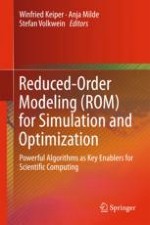This edited monograph collects research contributions and addresses the advancement of efficient numerical procedures in the area of model order reduction (MOR) for simulation, optimization and control. The topical scope includes, but is not limited to, new out-of-the-box algorithmic solutions for scientific computing, e.g. reduced basis methods for industrial problems and MOR approaches for electrochemical processes. The target audience comprises research experts and practitioners in the field of simulation, optimization and control, but the book may also be beneficial for graduate students alike.
